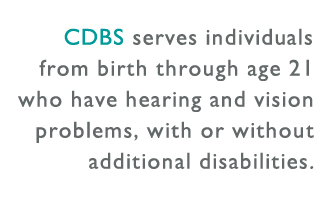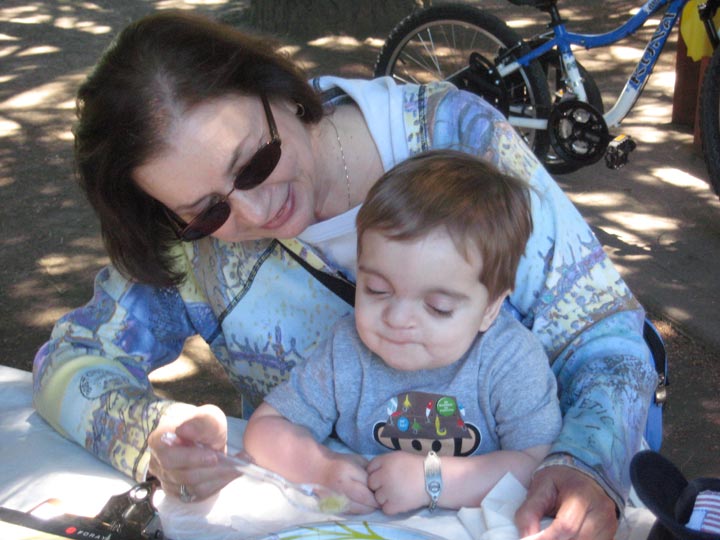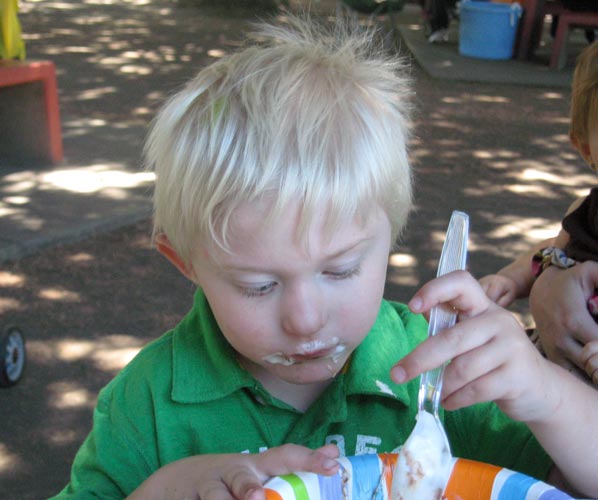CDBS serves individuals from birth through age 21 who have combined hearing and vision problems, with or without additional disabilities.
 We are now on Twitter! Follow us - @CADeafblind - or just visit our page at: https://twitter.com/CADeafblind for additional updates and information.
We are now on Twitter! Follow us - @CADeafblind - or just visit our page at: https://twitter.com/CADeafblind for additional updates and information.

Families and childcare providers: During these extraordinary times of school closures, CDBS staff is here to help. If you're struggling to find ways to engage your child in activities throughout the day, contact anyone at CDBS for tips, ideas, and strategies to support active engagement. Or if you just need someone to talk to. CDBS staff is committed to continuing all of our technical assistance activities, either by phone or Zoom.

Weekly Training
Activities 2021
CDBS will provide weekly mini-training activities for California families and educational teams via the Zoom platform on issues specific to distance learning during the pandemic. Training activities are planned for Tuesday afternoons from 3:30 – 4:15 PM (Pacific Standard Time) and will run from February through April (with no event on 3/2/21 so as to not conflict with the Texas Deafblind Symposium on the same date). Each training will be recorded and made available on the CDBS website. Please visit the Weekly Training Activities page for more details and links to trainings and recordings.
THANK YOU to everyone who joined us for this 1st series on Tuesdays Sept — Dec 2020.
Our new series starts Feb 9, 2021.

Annual Child Count of Students with Deafblindness — 2021
Our funder, the U.S. Department of Education, requires CDBS to conduct an annual child count to determine the number of children/students in California who are deafblind (i.e., children/students who are both blind/visually impaired and Deaf/hard of hearing). Our charge is to identify every child / student from birth to age 22 who is deafblind, regardless of their IEP category, as most students with deafblindness fall under a variety of other designations. This information is very important as it impacts policy and practice at local, state, and national levels. Thank you for your help.
Who should be Included on the Deafblind Census?
Many people who are deafblind have some usable vision and/or usable hearing. It is important to understand that persons who are completely deaf and totally blind, like Helen Keller was, make up only about six percent of the total group that is considered to be "deafblind." CDBS uses a functional definition of deafblindness:
If an individual (birth through age 21) has combined hearing and vision problems that are significant enough to require considerations (such as specialized adaptations, modifications, and strategies) when presenting information or interacting with the child, then that individual is considered eligible to receive CDBS services and should be included on the deafblind census.
For purposes of the annual census, a person is considered to be deafblind if they have both a documented vision impairment and are deaf / hard of hearing, ranging from mild to severe, or they function as if they have both a hearing and vision loss based on inconsistent responses to the environment or inconclusive responses during hearing and vision exams. A conclusion that a child is functionally deafblind may be based on an educational evaluation for purposes of initially reporting that child on the deafblind census. Please remember that regardless of the presence or absence of additional disabilities, children with combined hearing and vision problems should be included on the deafblind census. Students do not have to meet state or local criteria, since this census is separate from the state count, and most children in California with combined hearing and vision problems are, in fact, identified on their individualized educational program (Part B of the Individuals with Disabilities Education Act child count) in categories such as multi-disabled, intellectually disabled, visually impaired, or deafness.
In addition, students with a mild hearing loss and mild vision loss should be included since a combined mild loss of both senses can create an adverse effect on educational success.
2020-2021 Child Count / Census Forms and Deadline — Abridged due to Pandemic
We normally mail forms containing information on students reported to us last year for you to review and confirm information. We will be providing alternative means of verifying information for this year during the pandemic when most LEAs / districts in the state are not easily accessing all of their buildings or student records. If you have provided California Deafblind Services any census documents over the past 3 years, we will email questions and coded information to the Special Education Director (or other appropriate staff we have been in touch with) for your County / District / LEA to help us verify if any updates are needed or if there are any new students to report. Please expect these emails by February 27th, 2021.
If your offices (County / District / LEA) have received no emails by the end of February, 2021 and you do have students in your district that do qualify as deafblind as described above, please contact our Census Coordinator Brian Devereux at the email address below.
Local educational agencies that report no children or an unusually low incidence of children with deafblindness (as compared to the nationwide incidence) may be contacted by CDBS staff to assist with identification and child find activities.
Note: All information on these forms is to be treated as confidential. Please return census forms by March 30, 2021, to the California Deafblind Services Census Coordinator, Brian Devereux: devereux@sfsu.edu
Questions? Please contact Brian Devereux at devereux@sfsu.edu
For more information, please visit the Child Count section of our website:
https://www.cadbs.org/census/
(Update — Feb 1, 2021)
THIS EVENT HAS ALREADY OCCURRED
THANK YOU TO EVERYONE WHO JOINED US ON SAT JAN 30TH, 2021
THE VIDEO OF THE TRAINING SHOULD BE UP TO VIEW ON OUR "Videos" PAGE BY MID-FEBRUARY
Everyone who signed-up for the event will also receive a reminder email and link once the vido is posted online.
Thanks again to the Braille Institute and to everyone who participated!
Online event for January 30th, 2021 — Emergent Literacy Training Hosted by: Braille Institute & California Deafblind Services
FREE CHILD DEVELOPMENT TRAINING — A COLLABORATION WITH CALIFORNIA DEAFBLIND SERVICES
January 30, 2021, from 10:00 — 11:30 AM PST, ONLINE — on the Zoom meeting platform


Our Fall 2020 issue of reSources newsletter is available online!
-
Modifications and Accommodations while Virtual Learning
-
CDBS Annual Teacher Symposium in Deafblindness: The Sigal Family Lecture Series
-
Three Simple Lessons Learned So Far During this Time of Distance Learning
-
Hand-Under-Hand Guidance
-
My Distance Learning Diary
-
Creating a Photo Story of Your Child to Share with the Educational Team


Update — August 2020
CDBS Announces Modified Technical Assistance Model During the Pandemic
The staff of California Deafblind Services (CDBS) has revised our technical assistance model to better meet the needs of family members and educators during the pandemic and the switch—at least for now—to distance learning. We know that many families are struggling to support the education of their children while trying to juggle multiple responsibilities. For educators and agency personnel, we know that distance learning is a challenge for children and youth who are deafblind and we are here to help you best meet the needs of the children/students you serve.
Because face-to-face activities in schools, agencies and homes are not possible at this time, this temporary technical assistance (TA) model collapses the three previous levels of CDBS TA into one new level: Targeted TA. CDBS staff will meet all requests for targeted TA for the remainder of 2020.
FOR APPLICATION AND MORE INFORMATION,
VISIT THE TECHNICAL ASSISTANCE PAGE OF OUR SITE:
https://www.cadbs.org/how-does-technical-assistance-work-/
Looking for Training Activities During School Closures?
High Quality Professional Development Available at No Cost!
Attention paraeducators, administrators and other educational service providers: During this unprecedented time of California school closures, CDBS reminds you that the Open Hands Open Access intervener training modules are available for self-paced, customized professional development. While designed for intervener training, the Open Hands Open Access modules are also being used by teachers, related service personnel, family members, and university-based teacher training programs.
There are 26 web-based Open Hands Open Access modules grouped into five categories:
Impact of Deafblindness on Learning
- An Overview of Deaf-Blindness and Instructional Strategies
- The Sensory System, the Brain, and Learning
- Building Trusted Relationships and Positive Self-Image
- Availability for Learning
- Concept Development and Responsive Environments
- Introduction to Orientation and Mobility for Interveners
- Touch for Connecting and Learning
Communication
- Understanding Communication Principles
- Emergent Communication
- Progressing from Non-Symbolic to Symbolic Communication and Complex Language
- Touch for Connection and Communication
- An Introduction to Sign Language and Braille
Promoting Learning
- Routines for Participation and Learning
- Calendars
- Intervener Strategies
- Social Skills and Peer Relationships
- Maximizing Vision and Hearing
- Accessing the Curriculum and Environment
- Behavior and Environmental Supports
- Orientation and Mobility in Everyday Routines
Preparing for Adult Life
- Self-Determination
- Transition to Adulthood and Community Living
- Sexuality
Professionalism
- The Role of the Intervener in Educational Settings
- Collaborative Teaming and Family Partnerships
- Values, Ethics and Professionalism
To access Open Hands Open Access, go to: https://www.nationaldb.org/products/modules/ohoa/
For more information, contact CDBS Project Coordinator Maurice Belote at mbelote@sfsu.edu or leave a voicemail message at 415-405-7558.

New area for online resources and ideas!
https://wakelet.com/@CaliforniaDeafblindServices
UPDATE — April 8, 2020
The CDBS / SFSU
FOR MORE INFORMATION ABOUT
REQUESTING TECHNICAL ASSISTANCE (TA)
PLEASE VISIT THE SERVICES SECTION OF OUR PAGE AT: TECHNICAL ASSISTANCE











Creative! Challenging! Secure!
Enter a rewarding and exciting field with great people and many job prospects throughout the country. Find out about the Teacher Preparation Program in Visual Impairments at San Francisco State University.

 The contents of this website were developed under a grant from the US Department of Education, #H326T180015. However, those contents do not necessarily represent the policy of the US Department of Education, and you should not assume endorsement by the Federal Government. Project Officer, Susan Weigert.
The contents of this website were developed under a grant from the US Department of Education, #H326T180015. However, those contents do not necessarily represent the policy of the US Department of Education, and you should not assume endorsement by the Federal Government. Project Officer, Susan Weigert.







